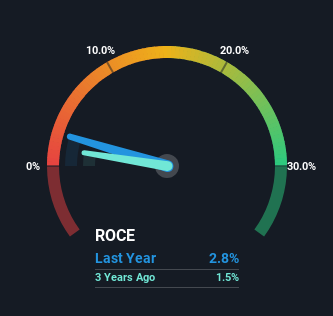- India
- /
- Paper and Forestry Products
- /
- NSEI:ABREL
Century Textiles and Industries (NSE:CENTURYTEX) May Have Issues Allocating Its Capital
To avoid investing in a business that's in decline, there's a few financial metrics that can provide early indications of aging. A business that's potentially in decline often shows two trends, a return on capital employed (ROCE) that's declining, and a base of capital employed that's also declining. This indicates the company is producing less profit from its investments and its total assets are decreasing. And from a first read, things don't look too good at Century Textiles and Industries (NSE:CENTURYTEX), so let's see why.
Return On Capital Employed (ROCE): What Is It?
Just to clarify if you're unsure, ROCE is a metric for evaluating how much pre-tax income (in percentage terms) a company earns on the capital invested in its business. The formula for this calculation on Century Textiles and Industries is:
Return on Capital Employed = Earnings Before Interest and Tax (EBIT) ÷ (Total Assets - Current Liabilities)
0.028 = ₹1.4b ÷ (₹85b - ₹34b) (Based on the trailing twelve months to September 2023).
Thus, Century Textiles and Industries has an ROCE of 2.8%. Ultimately, that's a low return and it under-performs the Forestry industry average of 13%.
View our latest analysis for Century Textiles and Industries

Above you can see how the current ROCE for Century Textiles and Industries compares to its prior returns on capital, but there's only so much you can tell from the past. If you'd like, you can check out the forecasts from the analysts covering Century Textiles and Industries here for free.
So How Is Century Textiles and Industries' ROCE Trending?
We are a bit worried about the trend of returns on capital at Century Textiles and Industries. To be more specific, the ROCE was 6.1% five years ago, but since then it has dropped noticeably. And on the capital employed front, the business is utilizing roughly the same amount of capital as it was back then. Companies that exhibit these attributes tend to not be shrinking, but they can be mature and facing pressure on their margins from competition. If these trends continue, we wouldn't expect Century Textiles and Industries to turn into a multi-bagger.
Our Take On Century Textiles and Industries' ROCE
In the end, the trend of lower returns on the same amount of capital isn't typically an indication that we're looking at a growth stock. But investors must be expecting an improvement of sorts because over the last five yearsthe stock has delivered a respectable 46% return. In any case, the current underlying trends don't bode well for long term performance so unless they reverse, we'd start looking elsewhere.
One more thing, we've spotted 3 warning signs facing Century Textiles and Industries that you might find interesting.
For those who like to invest in solid companies, check out this free list of companies with solid balance sheets and high returns on equity.
New: Manage All Your Stock Portfolios in One Place
We've created the ultimate portfolio companion for stock investors, and it's free.
• Connect an unlimited number of Portfolios and see your total in one currency
• Be alerted to new Warning Signs or Risks via email or mobile
• Track the Fair Value of your stocks
Have feedback on this article? Concerned about the content? Get in touch with us directly. Alternatively, email editorial-team (at) simplywallst.com.
This article by Simply Wall St is general in nature. We provide commentary based on historical data and analyst forecasts only using an unbiased methodology and our articles are not intended to be financial advice. It does not constitute a recommendation to buy or sell any stock, and does not take account of your objectives, or your financial situation. We aim to bring you long-term focused analysis driven by fundamental data. Note that our analysis may not factor in the latest price-sensitive company announcements or qualitative material. Simply Wall St has no position in any stocks mentioned.
About NSEI:ABREL
Aditya Birla Real Estate
Develops and leases real estate properties primarily in India.
High growth potential and slightly overvalued.
Similar Companies
Market Insights
Community Narratives




